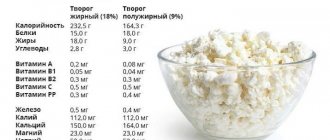Fermented milk products are good for health: they enrich the body with calcium, nutrients and bifidobacteria, giving gastronomic pleasure and quick satiety. However, when fresh, it lasts no more than 3 days, so the question remains relevant for many housewives: is it possible to freeze cottage cheese in the freezer?
Fermented milk products are rich in calcium and protein, have a pleasant taste and quickly fill you up. However, they are perishable and can only be preserved for a long time by freezing.
Freezing extends the shelf life of products and preserves their taste. However, it is important to properly organize storage. The tips and tricks collected in this article will help you freeze homemade cottage cheese correctly.
What happens to cottage cheese when frozen
Goat or cow's curd retains its health and nutritional properties when frozen. But when a fermented milk product begins to deteriorate, cooling it does not guarantee that pathogenic microorganisms will die. Cold does not improve its quality or kill germs. The only thing that can be achieved this way is to slow down the negative processes that lead to spoilage at temperatures above 0˚ C.
All known and unknown ways to quickly freeze ice into cubes
Transparent and smooth ice cubes are indispensable in the heat. They can be added not only to lemonade or juice, but even to coffee or tea,…
Freezing allows you to preserve the product in the form in which it was subjected to this processing, but only if the rules have been followed. The best option for preserving quality is blast freezing, maximum degree of cooling (about -35˚ C) and minimum cooling time. In the freezer, whose power reaches only -15˚ C, its structure changes. The liquid in it crystallizes, and after defrosting, the curd mass will separate, its taste characteristics will also deteriorate.
Curd products that cannot tolerate freezing
- Curd cheeses with fillings and glaze - when defrosted, they will simply turn into an unsightly mush due to their crushed consistency.
- You should be careful when freezing curd mixtures and masses - if you still want to freeze them, then ensure that the curd is dry, since frozen moisture will turn the curd mass into mush when defrosting.
Beneficial and harmful properties of frozen cottage cheese
The product is the result of separating the milk base from the whey, which causes high concentrations of nutrients in it. The lactic acid bacteria present in it break down proteins into amino acids, speeding up important body processes. In a product frozen according to the rules, useful components remain unchanged, which are represented by:
- Methionine is a component that prevents and slows down (if the condition has developed) atherosclerotic processes in the body.
- Choline is a compound that ensures the proper functioning of the nervous system.
- Lysine is a substance that helps the liver cope with its function.
These components make cottage cheese one of the essential baby food products. But for an adult it is also necessary, especially when there is deterioration in the functioning of the heart, digestion, and joints. In fact, it is beneficial for everyone except those people who are lactose intolerant. But the benefit is completely absent in cases where storage conditions were violated. Bacteria begin to actively develop in cottage cheese, which can cause serious food poisoning.
Reference! The low fat content of the product and the beneficial components it contains, as well as a large amount of calcium, allow it to be consumed during periods of dieting. It also contains other substances that prevent a decrease in skin tone and prevent brittleness of nails and hair with a calorie-restricted diet.
Freezing cottage cheese in the freezer
Simply loading the cottage cheese into a plastic bag and putting it in the freezer is not enough. At home, you need to follow rules that will prevent its damage. When it is frozen correctly, the product can be used at any time - its qualities will be preserved and dishes prepared with it will be tasty. The main principles of home freezing are:
- For freezing in a household freezer, it is recommended to use a fresh farm product; store-bought products do not tolerate this procedure well.
- There is no point in freezing a pasty curd mass; the product must be grainy, otherwise it will separate.
- It is recommended to keep it in a ceramic container that is hermetically sealed - this will prevent the product from losing moisture and preserve its taste.
- It is not recommended to fill the container to the brim, since the volume increases during the freezing process; there should be about 2 cm left to the edge.
- Plastic bags are not suitable; the product will spoil in them.
- The temperature in the freezer after freezing (in the “super freezing” mode, complete cooling time is 4-6 hours) should be at -18˚ C.
After thawing, the cottage cheese cannot be re-frozen, so the product is packaged before sending it to the freezer in small portions that can be consumed at a time. To avoid accidentally consuming a spoiled product, each container containing it must be labeled with the date of freezing. There is no difference in the preparation process and freezing of goat or cow curd.
How to preserve strawberries so they stay fresh for a long time (there is a secret)
Strawberries are a favorite berry of adults and children, thanks to their aroma and taste. But the nutmeg strawberry season...
Quick defrosting methods
You can quickly defrost cottage cheese from the freezer only if you plan to use it immediately. All these methods may be unsafe.
| Fast defrosting method | Time needed | Peculiarities |
| At room temperature | 2-3 hours | The product may spoil, especially if the room is hot. |
| In cold water | 3-6 hours | Suitable mainly for small bags or containers of cottage cheese. |
| In hot water | 1-1.5 hours | The product may not be heated evenly and its texture will become thinner. |
| In the microwave | up to 10 min. | Cottage cheese can only be defrosted at minimum microwave power. |
| In the oven | 30 min. | Only permissible at temperatures around 30°C. |
| In a slow cooker | 10-30 min. | The product may absorb liquid from the steam and become watery. |
At room temperature
This method is used when the product will be subjected to immediate heat treatment. To quickly defrost cottage cheese, you need to remove it from the freezer and leave it indoors for 2-3 hours in a sealed zip bag or container.
After the specified time has passed, you need to drain all the liquid from it and start cooking.
In cold water
To speed up the process of defrosting cottage cheese, you can place the container or bag of frozen product in cold or warm water. This way it will thaw within a few hours, depending on the serving size and packaging (bags defrost faster).
In the microwave
You can quickly defrost cottage cheese from the freezer in the microwave. To do this, you will need to use the lowest power of the electrical appliance in the defrosting mode (or using the option for bread or seafood, depending on the model and functionality).
The basic rule when defrosting cottage cheese in the microwave is that it should remain cold during the process. To do this, heat it at the specified mode in sessions of 1-1.5 minutes, after which take breaks of 30 seconds. and turn it over every time. A product packaged in a bag will defrost faster compared to a container.
In the oven
Thawing the product in the oven at high temperatures is not recommended in the same way as in hot water. However, some modern models of kitchen equipment have special modes that allow slow, smooth heating. In this case, you will need to preheat the oven to 30°C and turn on convection, then place the cottage cheese in it for 10 minutes. Halfway through this time, it is recommended to turn the product packaging over.
In a slow cooker
You can quickly defrost cottage cheese from the freezer in a slow cooker. To do this, you will need to place the packaged product on the grill and turn on the electrical appliance in steamer mode. In this case, it is necessary not to close the lid and turn the product over from time to time. This will ensure even defrosting and prevent excess moisture.
In hot water
When the package is placed in a container with hot water, the outer layer of cottage cheese will quickly thaw, but the inside will remain frozen. Its quality will be noticeably deteriorated - it will become liquid and inhomogeneous.
How to quickly defrost cottage cheese - this can be done in hot water.
Therefore, this method can only be used for defrosting small packages and only when absolutely necessary.
Tips for defrosting
It is not necessary to wait until the cottage cheese thaws to an acceptable temperature. The mass can be passed through a meat grinder or scrolled in a blender. Although “chopped” it will be cold, you can work with it without waiting for defrosting. In addition, even complete thawing will take place faster.
Cold cottage cheese can be used to make casseroles, cheesecakes or pancake filling. Even if the mass is not completely warmed up before going into the oven, this will not affect the taste of the finished dish or its appearance.
Packaging options for freezing cottage cheese
To create suitable conditions for preserving the quality of the product, you need to focus on the packaging in which it will be sent to the freezer for storage. In addition to plastic bags, which are not suitable for fermented milk products, there are other options. It is permissible to freeze cottage cheese at home in the freezer in the following types of packaging:
- vacuum;
- parchment paper and foil;
- cotton fabric;
- glass and enamel dishes;
- plastic food containers.
It is possible to organize vacuum packaging at home when you have a special device - a vacuum dehumidifier. This device is expensive, but it allows you to provide better conditions for storing different types of products, not just cottage cheese. Vacuum packaging preserves the original taste characteristics of the fermented milk product for 1 month. The integrity of the vacuum packaging should only be broken before use.
Reference! Home packaging of products using a vacuum sealer is virtually no different from industrial packaging.
To preserve its taste and consistency, cottage cheese can be wrapped in foil or parchment paper. This packaging option briefly extends its shelf life, but foil and parchment paper have another advantage. Compared to glass or enamel dishes, they help save space in the freezer.
Cotton fabric is a good option for storing fermented milk products. The cottage cheese is wrapped in a slightly damp cloth and placed in a container. The dishes are closed and sent to the freezer. This packaging method prevents weathering and preserves the necessary moisture of the product. Cotton fabric also needs to be placed between the walls of the glass or ceramic container and the cottage cheese, which preserves the friability of the product. In addition, to store it in such a container, you need to put 2-3 cubes of refined sugar in the container, which will not allow the cottage cheese to become unusable ahead of time.
Plastic containers are not suitable for storing and freezing fermented milk products. Plastic, even food grade, can absorb odors and release them to the products stored in it. Therefore, the container used must be absolutely clean and free of foreign odors. You should also place a paper towel or cotton napkin at the bottom of the plastic container. This measure will minimize contact with plastic and maintain the consistency of the curd.
Cheesecakes in the freezer
You can make a semi-finished product from fresh fermented milk - cheesecakes or sweet dumplings and put them in the freezer.
When you want to enjoy homemade bread, all you have to do is quickly defrost it, fry it or boil it, and then be glad that you took care of yourself and stocked up in advance.
How to freeze cheesecakes? Just like dumplings and dumplings in a convenient container with generous use of flour so that semi-finished products do not stick together!
Storage period for frozen cottage cheese
Cottage cheese that has been frozen cannot remain in the freezer for a long time - it gradually begins to lose its nutritional and taste characteristics. Depending on the capacity of the freezer, it can stay fresh for up to two months. The table shows the shelf life of cottage cheese depending on the temperature maintained in the freezer.
| Freezer temperature | Storage time |
| -6…0˚ C | up to 6 days |
| -18…-12˚ C | up to 14 days |
| -35˚ C | up to 60 days |
Attention! Up to two months, frozen cottage cheese is edible only in case of accelerated (super freezing or shock) cooling.
Deadlines
How long cottage cheese is stored in the freezer depends, first of all, on the temperature in the chamber:
- at -2 °C it is possible to save the product for a week in advance;
- from -12 to -18 °C, cottage cheese can sit without spoiling for two weeks;
- at -25 °C freshness is maintained for 20 days;
- in deep freezing (-35 °C) the workpiece will “live” for up to a month.
Note: high-fat cottage cheese can be stored in the freezer with minimal loss of consistency quality, while its dietary counterpart becomes very crumbly and dry.
Remember, it is still important to know the expiration date of the cottage cheese you purchased in order to avoid freezing and subsequent use of an already stale product.
Defrosting cottage cheese
A product from the freezer, if the cooling and defrosting rules are followed, will not change its consistency and taste characteristics. There are two main points that must be followed when defrosting - gradual thawing and the absence of a sharp temperature increase. In order for the product to thaw gradually, it is sent from the freezer to the bottom shelf in the refrigerator compartment. The process is not fast, it can take up to 18-24 hours, especially when a large volume has been frozen.
Curd ice cream Creme Brulee in just 7 minutes
Homemade Creme Brulee ice cream only has 2 ingredients - cottage cheese and boiled condensed milk, but it turns out incredibly tasty and...
It is impossible to leave cottage cheese at a temperature immediately above 20˚ C, as this will change the properties of the product and it will become unsuitable even for use for culinary purposes. It is not recommended to defrost in a microwave oven - this will negatively affect the structure of the fermented milk product and its nutritional qualities. The beneficial substances in the cottage cheese will begin to disintegrate with this defrosting option.
Freezing semi-finished curd products
Sticking dumplings, cheesecakes, dumplings, wrapping the sweet curd filling in pancakes, and then quickly freezing it all is an excellent alternative to store-bought semi-finished products. There will always be a preparation at hand for a quick breakfast or treating unexpected guests.
Important: such stocks do not need to be defrosted; they can be fried or boiled immediately. Otherwise, the result will not be satisfactory: the curd dough will become loose and fall apart, and the filling will spread.
The terms and temperature conditions for storing dough pieces and fermented milk products correspond to those indicated above. Consuming spoiled dairy products can lead to serious food poisoning.
Using frozen cottage cheese
Thawed cottage cheese, which has been cooled according to the rules and thawed in the refrigerator compartment, can be eaten fresh, without subsequent heat treatment. But, it is better to use such cottage cheese as part of other dishes, especially when it has been defrosted quickly. After freezing, it can be used in many dishes, but more often such cottage cheese is used to prepare the following:
- cheesecakes;
- casseroles – sweet and salty;
- added to yeast dough;
- cottage cheese cookies;
- pies and buns with curd filling;
- dumplings, including lazy ones.
Cottage cheese that has been frozen and thawed does not actually change its original properties. But, in its raw form, its taste deteriorates slightly - relative to a completely fresh product. Cottage cheese tolerates freezing quite easily and, when large supplies of this product are needed or there is excess left, sending it to the freezer is a good option. This solution will allow it to be used for culinary purposes in the future.
You can freeze cottage cheese at home, but this requires a high-power freezer that can maintain the inside temperature at -18˚ C or less. When the freezer is low-power, it is undesirable to freeze the product in it, since its quality will deteriorate due to excessively slow cooling. With proper freezing and gradual thawing of the product, without a sharp increase in temperature, the product's structure and taste will remain unchanged. It can be eaten fresh or used for culinary purposes.
How to recognize a delay and what to do about it
It is very important to recognize in time that the product is expired and can no longer be stored. Obvious signs of expired cottage cheese are:
- sharp, pronounced sour odor;
- bitter taste;
- “loose” consistency (part of the mass has become liquid, the other has dried);
- grayish-yellow color;
- the appearance of mold spots.
Some housewives use slightly sour cottage cheese to make casseroles, cheesecakes, or in home cosmetology (recipe in the video below). Of course, we are only talking about a slightly expired product.
If the cottage cheese tastes bitter, a musty smell has appeared, and even more so mold has appeared - under no circumstances should it be eaten.
Every housewife should know the basic rules for storing cottage cheese in the refrigerator or in some unforeseen situation using old grandmother's methods. How to freeze and defrost it correctly, recognize when it’s expired and what to do about it. Then this valuable dairy product will only benefit you.
Fermented milk products are good for health: they enrich the body with calcium, nutrients and bifidobacteria, giving gastronomic pleasure and quick satiety. However, when fresh, it lasts no more than 3 days, so the question remains relevant for many housewives: is it possible to freeze cottage cheese in the freezer?











